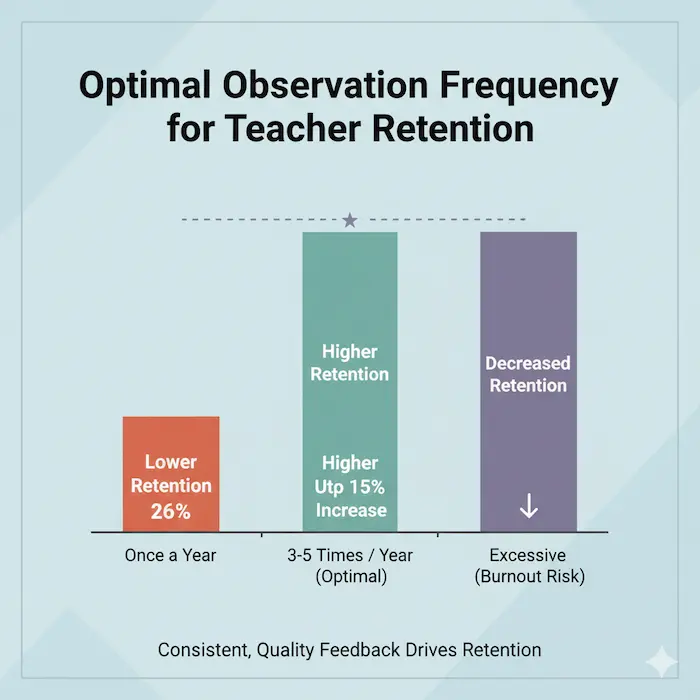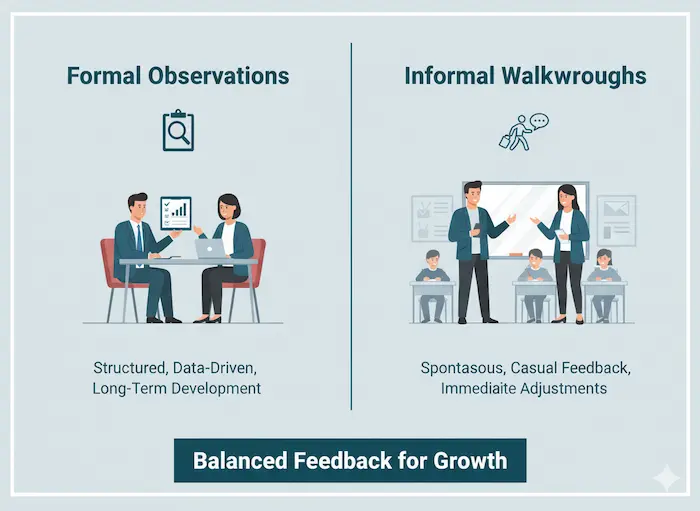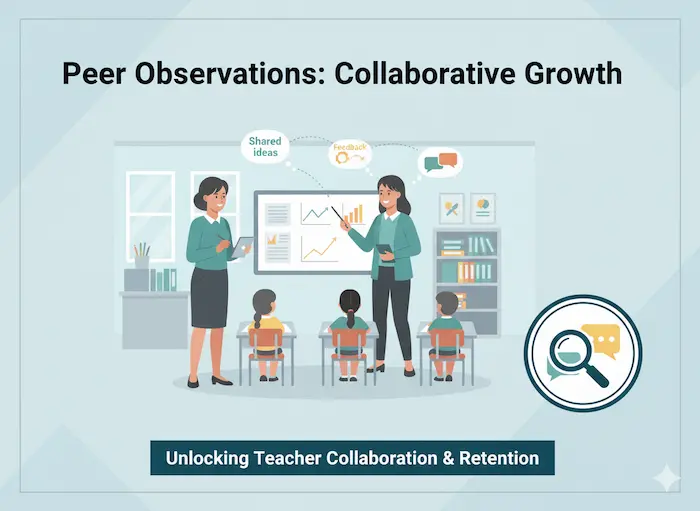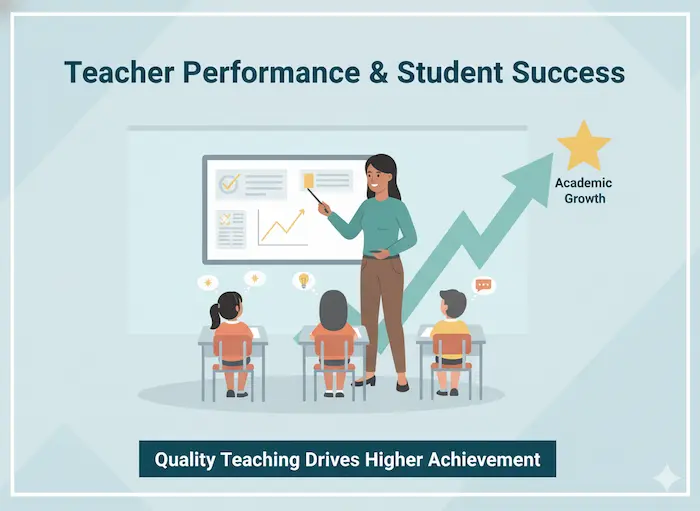Classroom observation frequency directly impacts teacher retention by providing consistent, constructive feedback that fosters trust, accountability, and professional growth. Regular, supportive observations make teachers feel seen and valued, leading to higher morale and lower turnover. This article explains the optimal observation frequency, the role of timely feedback, and how balancing different observation types can reduce burnout.
Key Takeaways
- Classroom observations are vital for teacher retention, with consistent support through feedback fostering trust and commitment among educators.
- An optimal observation frequency of 3 to 5 times per year enhances teacher satisfaction and retention while mitigating burnout from excessive evaluations.
- The quality of observations, including timely and constructive feedback, as well as incorporating peer evaluations, significantly boosts teacher satisfaction and contributes to improved student outcomes.
Why Are Classroom Observations Important for Teacher Retention?
Classroom observations are important for retention because they build a system of supportive, consistent feedback that strengthens teacher trust, morale, and job satisfaction.
Educators who feel acknowledged and supported through this process tend to stay longer and invest more in their roles. In fact, research from Gardner-Webb University shows that environments with regular, constructive feedback correlate with higher job satisfaction and lower turnover. This system transforms evaluation from a simple formality into a core pillar of a supportive school culture that retains high-quality educators.
Observations provide direct insight into teacher practices, teaching strategies, and classroom teaching that shape student learning. A practical observation highlights strengths and points to next steps for growth, enabling meaningful professional progress. One large-scale review found that teachers in schools with frequent observation and strong feedback loops reported higher retention and improved student outcomes.
The frequency and design of observation systems are critical factors in their success. This balance is essential because both extremes negatively impact retention. Too few touchpoints leave educators feeling unsupported and disconnected from leadership, while too many or overly rigid evaluations increase stress and risk burnout. A well-balanced system ensures that teachers think an appropriate level of support and accountability (cared for) rather than a constant, high-stakes scrutiny
Effective observation systems that boost retention share several key features:
- Differentiated Schedules: Tailoring observation frequency based on a teacher’s experience and context.
- Informal Walk-throughs: Using low-stakes, informal visits to promote improvement, not just evaluation.
- Multiple Observers: Involving multiple administrators or peers to reduce bias and increase reliability.
- Actionable Feedback: Providing immediate, actionable feedback aligned with professional development goals.
- Peer-Involvement: Shifting the dynamic from evaluation to collaboration through peer observation.
- Full Transparency: Using a transparent process that builds consistency and fairness in measuring performance
When a system incorporates these elements, the effect is powerful. Teachers become more engaged, motivated to refine their craft, and committed to their schools. Over time, this environment attracts and retains high-quality educators, resulting in stronger teacher quality, more stable staffing, and enhanced student academic success.
What Is the Optimal Observation Frequency for Teacher Retention?

Research from the American Educational Research Association (AERA) in 2022 shows that schools that conduct regular, structured observations see up to 15% higher teacher retention than those that rely on once-a-year evaluations. Frequent, meaningful visits help educators feel recognized and guided, key factors in sustaining motivation and long-term commitment.
Finding the Optimal Range (3-5 Times per Year)
According to leading educational researchers, the optimal observation frequency is three to five times per year. This range allows teachers to apply feedback, refine teaching strategies, and demonstrate growth without feeling micromanaged. Systems like Tennessee’s TEAM model, which requires six observations for apprentices and four for veterans, link consistent coaching to stronger teacher performance and measurable gains in student learning and academic success.
When tied to professional development, frequent observations enhance both teacher practices and teacher quality. They give educators time to reflect, adjust, and embed improvements in their classroom teaching, turning evaluations into meaningful opportunities for growth.
At Carroll County Middle School in Kentucky, instructional coach Mandy Young redefined observation culture through a balanced mix of formal evaluations and short walkthroughs. Feedback was given within hours, specific and actionable. Instead of dreading observations, teachers began requesting more, eager to see how their efforts translated into progress. Within one semester, retention and morale increased, showing how structured yet flexible observation cycles can transform school culture. Read the complete case study.
Spacing Observations to Prevent Burnout
Experts recommend spacing sessions three to six weeks apart, giving teachers time to practice and internalize changes. Too much time between visits weakens consistency, while too many in quick succession can cause fatigue. Many schools now use digital tools to coordinate schedules, track insights, and ensure that every observation contributes to ongoing improvement.
Careful planning and collaborative feedback create an observation system that empowers educators rather than simply evaluating them. The result is stronger classroom practices, higher teacher quality, and meaningful, sustained student learning.
Balancing Formal and Informal Observations

Teachers thrive when structure and flexibility work together. Research from the American Educational Research Journal found that combining formal evaluations with frequent informal visits increases teacher satisfaction and retention by more than 12%, as regular feedback builds confidence and strengthens classroom teaching.
Formal observations provide a clear, data-driven view of teaching strategies and teacher practices, guiding long-term professional development and supporting fair assessments of teacher performance. Informal walkthroughs keep things natural and open. They capture authentic classroom practices, reduce stress, and provide quick, actionable feedback that helps teachers make minor improvements that lead to stronger student learning.
To make feedback more balanced, many schools use a mix of perspectives:
- Internal observations highlight school culture and instructional context.
- External reviews bring objectivity and uncover patterns that might be overlooked.
This balance gives leaders a more complete view of teacher quality and its connection to real growth.
Technology now makes it easier to manage both types of observations. With Education Walkthrough, schools can record visits, share instant feedback, and use built-in analytics to track progress, all from a single platform. Templates are customizable, feedback is stored automatically, and communication stays transparent.
When formal and informal observations complement each other, feedback becomes a shared process instead of a checklist. Teachers feel supported, students experience better instruction, and schools cultivate a culture built on trust and continuous improvement.
Try Education Walkthrough today
The Role of Timely Feedback in Teacher Retention
Timely feedback is one of the most effective ways to keep teachers engaged and growing. When it’s given soon after an observation, it stays relevant, helps teachers act quickly, and builds confidence in their classroom teaching.
Studies from the National Center for Analysis of Longitudinal Data in Education Research found that teachers who receive feedback within 48 hours are more likely to improve their teaching strategies and stay in their schools longer.
| Role of Timely Feedback | How It Supports Retention |
| Keeps reflection fresh | Teachers can connect comments to recent lessons and apply them immediately. |
| Improves teaching strategies | Quick insights encourage experimentation and steady growth in teacher performance. |
| Builds professional trust | Timely feedback shows that administrators value teachers’ efforts, reducing turnover. |
| Encourages collaboration | Immediate, constructive input opens conversations between teachers and observers. |
| Strengthens student learning | Faster instructional adjustments lead to more responsive classrooms and better outcomes. |
Impact of Observation Quality on Teacher Satisfaction
The way classroom observations are done can make a big difference in how teachers feel about their work. When observations focus on growth instead of strict evaluation, teachers feel supported, motivated, and more connected to their purpose. High-quality feedback helps strengthen teacher quality, refine teaching strategies, and improve classroom practices, leading to better student learning.
Here’s how meaningful, high-quality observations positively impact teachers and schools.
Builds Confidence and Motivation
When feedback highlights what teachers are doing right and offers clear ways to improve, they feel more confident in their abilities. This sense of progress boosts teacher performance and helps them see how their efforts directly influence student achievement.
Strengthens Teaching Strategies
Good observations do more than point out problems. They help teachers refine their classroom teaching with practical, specific advice. When observations are conducted with clear goals, they lead to steady improvements that add up to stronger instruction over time.
Guides Professional Development
High-quality feedback gives schools the insight they need to plan relevant professional development. Coaching sessions and workshops become more meaningful when grounded in real classroom data, helping teachers grow in ways that truly impact student learning.
Encourages Reflection and Growth
Video-based or recorded feedback gives teachers the chance to see their lessons from a new angle. Reviewing their classroom practices helps them notice what works, what needs improvement, and how to keep progressing while strengthening teachers’ knowledge and long-term growth.
Builds Trust and Retention
Teachers stay longer when the observation system feels fair and transparent. A process focused on learning rather than judgment encourages open communication and makes teacher evaluation more supportive. Over time, that trust leads to higher morale and stronger results for both teachers and students.
Peer-Conducted Observations: A Missed Opportunity?

Peer observations allow teachers to learn from one another in a low-pressure, growth-oriented way. Instead of feeling evaluated, educators feel supported through shared insight and reflection.
Studies show:
- Schools using structured peer observation programs report a 23% increase in teacher collaboration and satisfaction.
- Teachers who engage in peer feedback improve classroom practices and teaching strategies faster than those evaluated only by administrators.
Despite these benefits, fewer than 50% of U.S. districts use peer-conducted observations as part of their observation system. This gap means schools miss a cost-effective way to strengthen teacher quality and retention.
With Education Walkthrough, teachers can easily record peer visits, share notes, and track progress digitally. It simplifies collaboration and turns peer feedback into actionable insights.
Try Education Walkthrough today
Reducing Teacher Burnout Through Effective Evaluation Systems
Teacher burnout is a significant issue in the education sector, often driven by a lack of reflection on effectiveness and administrative inefficiencies. Well-designed observation systems can mitigate teacher burnout by providing the necessary support and reducing stress. Feeling overwhelmed before, during, and after classroom observations is common due to high stakes and pressure to perform well. Excessive or high-stakes observation can trigger teacher burnout and attrition.
Anxiety and perceived stress are predicted by workload, student behavior, and employment conditions, with a lack of administrative support being the single most significant factor increasing anxiety. Louisiana’s new Educator Advancement and Development System (LEADS) rewards effective veterans while providing the support early-career teachers need. This approach helps reduce stress and burnout by ensuring that teachers receive the support they need to succeed.
In our experience, implementing effective evaluation systems has significantly reduced teacher burnout. Regular support and constructive feedback create a more positive and supportive environment for teachers. This approach not only improves teacher retention but also enhances the overall quality of education, leading to better student outcomes, as supported by current research.
Case Studies: Successful Implementation of Observation Systems
At the Arizona School for the Deaf and the Blind (ASDB), classroom walkthroughs were once slow, paper-based, and inconsistent. Meghan Boyle, the school’s instructional leader, managed only one walkthrough per classroom each semester. Feedback was handwritten, often delayed, and rarely tied to measurable goals.
After adopting the Education Walkthrough, everything changed. Meghan now completes at least one walkthrough per classroom each quarter, plus weekly drop-ins, across more than 40 classrooms. Teachers immediately began seeing more precise feedback and faster growth, supported by digital summaries that helped them track progress and refine goals.
Key Results with Education Walkthrough:
- Increased visibility and accountability: Administrators now log and review walkthroughs in real time, keeping instructional leaders more connected to classrooms.
- Data-driven professional development: Insights from walkthrough data helped identify classroom environment as a shared growth area, leading to stronger school-wide improvement plans.
- Flexible templates that ease anxiety: Teachers reported less stress thanks to customizable templates that made feedback more approachable and specific.
- Enhanced accessibility through ASL video integration: The ability to embed messages in American Sign Language (ASL) ensured that all staff could access professional development materials, making inclusivity a core part of their observation process.
The result was a culture shift built on reflection, data, and collaboration. Administrators became more visible, teachers felt supported, and professional growth became a shared journey.
See how Education Walkthrough can transform your school. Book a Demo.
Addressing Systemic Inequities in Observation Scores
Systemic inequities in teacher observation scores based on student backgrounds are a significant issue in teacher evaluations. Teachers with students from higher incoming achievement levels receive classroom observation scores that are, on average, significantly higher than those of teachers with lower-ability students. Adjusting observation scores based on student backgrounds can lead to more equitable evaluation processes for teachers.
Effective evaluation systems should integrate resources that support teachers in underperforming schools to enhance their observation scores. Adjusting observation scores based on student background characteristics provides a straightforward fix for this systemic inequity. Addressing these inequities enables schools to create a fairer, more supportive evaluation system.
In our experience, implementing adjustments for student background characteristics has led to more equitable evaluation processes. Teachers in underperforming schools receive the support they need to improve their observation scores, resulting in higher retention rates and better overall performance
This approach not only benefits teachers but also contributes to improved student outcomes, highlighting a more positive school culture.
The Relationship Between Teacher Performance and Student Achievement

Strong teaching directly translates to stronger learning outcomes. Studies consistently show that students taught by highly effective teachers gain up to an additional year of academic growth compared to those taught by less effective teachers. This connection makes teacher performance one of the most critical factors in overall educational success.
The National Bureau of Economic Research found that the Dallas ISD appraisal system, which combined multiple evaluation measures and performance-based pay, led to significant gains in math and reading over time. These results highlight how balanced evaluation systems and value-added measures can meaningfully improve student achievement.
Fairness is equally essential. When teacher evaluations fail to account for student demographics or classroom context, teachers in high-poverty schools can be unfairly rated. Training evaluators and adjusting for systemic differences help ensure that all teachers are assessed based on teaching quality rather than circumstance.
Retention data supports this: 60 percent of highly effective teachers remain in their schools after three years, compared to only 26 percent of lower-rated peers. Schools that recognize and reward effectiveness not only retain stronger educators but also build a lasting culture of growth and excellence.
Ultimately, supporting teacher performance strengthens both teachers and students. By focusing on fair, data-informed evaluations and continuous feedback, schools create an environment where great teaching and great learning thrive.
Summary
Classroom observations are one of the strongest tools for improving teacher retention and overall teaching quality. When schools use structured observation systems that balance frequency, feedback, and support, teachers feel more valued and motivated to grow. Integrating formal, informal, and peer-led observations encourages collaboration and continuous professional development.
Addressing inequities in observation scores and maintaining a strong link between teacher performance and student achievement help create fairer, more effective evaluation systems. Schools that follow data-driven best practices see higher retention, stronger student learning, and a more positive school culture.
Investing in practical observation tools is an investment in the future of education. With Education Walkthrough, schools can streamline observations, provide real-time feedback, and turn classroom visits into measurable growth.
Frequently Asked Questions
Got questions about classroom observations? Explore quick answers on frequency, feedback, and best practices that help teachers grow and students succeed.
How often should classroom observations be conducted to improve teacher retention?
Conducting classroom observations at least three to five times a year is recommended to improve teacher retention rates effectively. Regular feedback and support can create a more engaging and supportive environment for educators.
Why is timely feedback important after classroom observations?
Timely feedback after classroom observations is crucial, as it allows educators to make immediate adjustments to their teaching practices and ensures the feedback is relevant and actionable. Receiving this information within 24 to 48 hours maximizes its effectiveness.
What are the benefits of combining formal and informal observations?
Combining formal and informal observations enhances the understanding of instructional effectiveness and promotes ongoing improvement among educators. This integrated approach ensures a well-rounded assessment of teaching practices.
How can systemic inequities in observation scores be addressed?
Addressing systemic inequities in observation scores can be achieved by adjusting evaluations to account for student backgrounds, promoting a fairer assessment process for teachers. This approach ensures that all educators are judged on a level playing field.
What is the impact of teacher performance on student achievement?
Teacher performance has a significant impact on student achievement; those who excel in standards-based evaluations tend to generate greater learning gains for their students. Investing in teacher quality is thus essential for enhancing educational outcomes.



